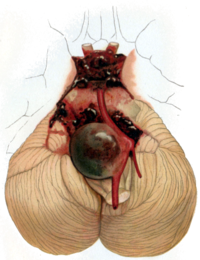
Photo from wikipedia
RATIONALE AND OBJECTIVES To investigate radiomics features of hepatic fat as potential biomarkers of type 2 diabetes mellitus (T2DM) and metabolic syndrome (MetS) in individuals without overt cardiovascular disease, and… Click to show full abstract
RATIONALE AND OBJECTIVES To investigate radiomics features of hepatic fat as potential biomarkers of type 2 diabetes mellitus (T2DM) and metabolic syndrome (MetS) in individuals without overt cardiovascular disease, and benchmarking against hepatic proton density fat fraction (PDFF) and the body mass index (BMI). MATERIALS AND METHODS This study collected liver radiomics features of 310 individuals that were part of a case-controlled imaging substudy embedded in a prospective cohort. Individuals had known T2DM (n = 39; 12.6 %) and MetS (n = 107; 34.5 %) status, and were divided into stratified training (n = 232; 75 %) and validation (n = 78; 25 %) sets. Six hundred eighty-four MRI radiomics features were extracted for each liver volume of interest (VOI) on T1-weighted dual-echo Dixon relative fat water content (rfwc) maps. Test-retest and inter-rater variance was simulated by additionally extracting radiomics features using noise augmented rfwc maps and deformed volume of interests. One hundred and seventy-one features with test-retest reliability (ICC(1,1)) and inter-rater agreement (ICC(3,k)) of ≥0.85 on the training set were considered stable. To construct predictive random forest (RF) models, stable features were filtered using univariate RF analysis followed by sequential forward aggregation. The predictive performance was evaluated on the independent validation set with area under the curve of the receiver operating characteristic (AUROC) and balanced accuracy (AccuracyB). RESULTS On the validation set, the radiomics RF models predicted T2DM with AUROC of 0.835 and AccuracyB of 0.822 and MetS with AUROC of 0.838 and AccuracyB of 0.787, outperforming the RF models trained on the benchmark parameters PDFF and BMI. CONCLUSION Hepatic radiomics features may serve as potential imaging biomarkers for T2DM and MetS.
Journal Title: Academic radiology
Year Published: 2020
Link to full text (if available)
Share on Social Media: Sign Up to like & get
recommendations!